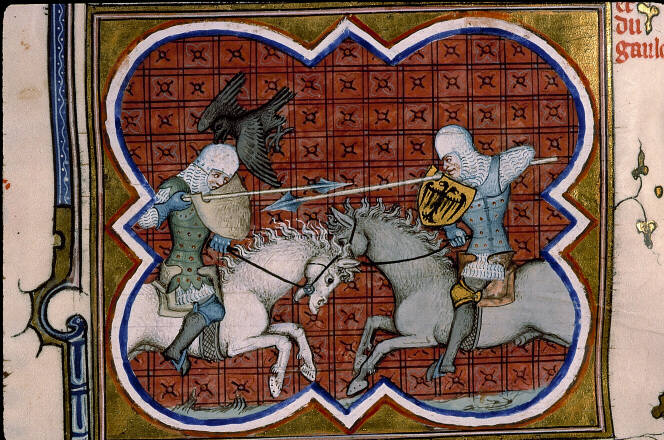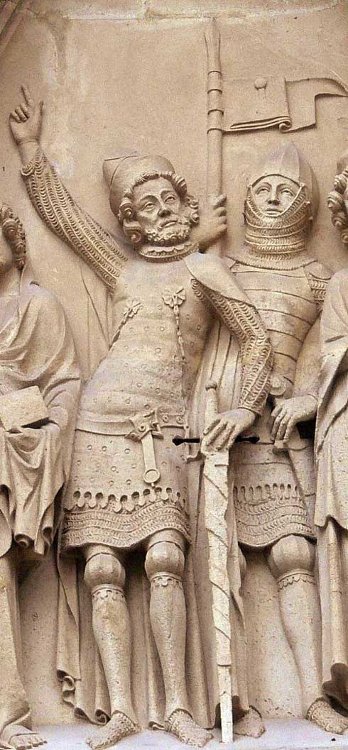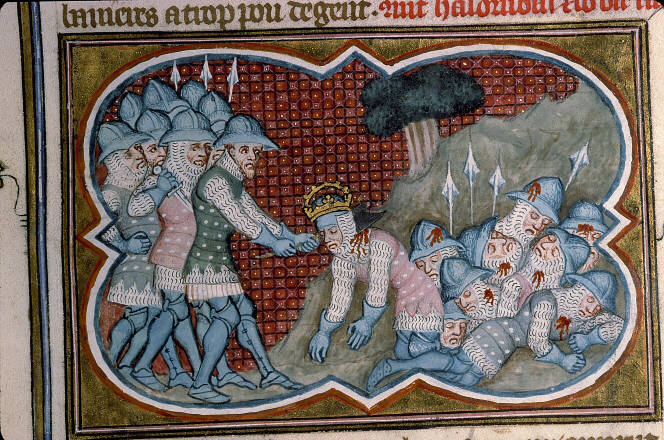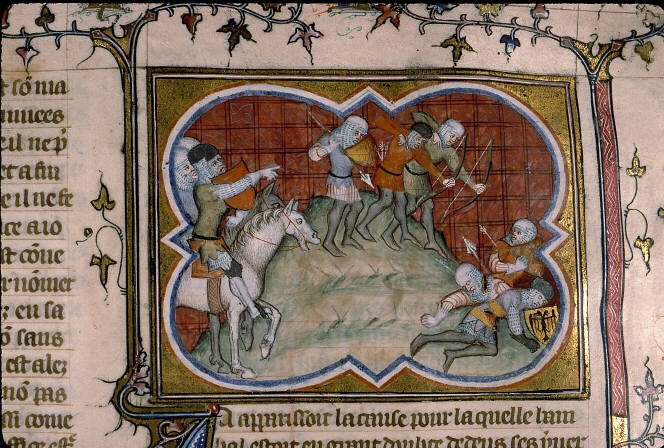| Author |
Message |
Artis Aboltins

|
 Posted: Mon 05 Nov, 2012 8:57 am Post subject: Construction of COP of Sir Miles Stapleton (1364) Posted: Mon 05 Nov, 2012 8:57 am Post subject: Construction of COP of Sir Miles Stapleton (1364) |
 |
|
There is plenty of funerary effigies and brasses, showing knights of second part of 14th century wearing various garments, that appear to be "pairs of plates" or "coat of plates". One of those is that of Sir Miles Stapleton. On the funerary brass http://effigiesandbrasses.com/monuments/miles.../original/ it is possible to make out what seems to be 17 rows of rivetheads. What makes me wondering are, actually, two things:
1)the armour appears to be waisted, unlike majority of surviving COPs (Visby, Kussnach, etc). Would that indicate something more alike later waisted brigandines in construction than Visby style COP?
2)there is significantly more rows of rivetheads than in vast majority of COPs - only Visby 22 and 24 would approach the amount. Would it be possible that like on the Visby style gauntlets, at least part of those rivetheads are more or less decorative, or just additional to the needed ammount to keep plates in order?
Now, first question can be approached by saying that it is actually a covered breastplate/fauld combination, like famed Munchen breastplate, however, it does not seem to be the case - there are brasses where it is possible to clearly identify the covered breastplates, and in none of those rows of rivets are parallel to eachother on the breastplate itself, only on faulds. At the same time, such "waisted COPs" are observable on the number of brasses and effigies.
Any ideas, comments?
|
|
  |
 |
Mackenzie Cosens

Location: Vancouver Canada Joined: 08 Aug 2007
Posts: 238
|
 Posted: Mon 05 Nov, 2012 10:15 am Post subject: Posted: Mon 05 Nov, 2012 10:15 am Post subject: |
 |
|
Sir Miles Stapleton brass is not what I would call "photo realistic" so there could be lots of plausible interpretations. I would lean to the Stapleton COP being similar to those seen in the bible Sainte-Genevieve http://vitezek.io.ua/album10931
Some of these I would interpret as being made of horizontal strips of metal some with breastplates others more like Kussnach
mackenzie
 Attachment: 100.97 KB Attachment: 100.97 KB

|
|
  |
 |
Kai Lawson

|
 Posted: Mon 05 Nov, 2012 11:48 am Post subject: Posted: Mon 05 Nov, 2012 11:48 am Post subject: |
 |
|
It seems possible to me that vertically-oriented plates could in fact be waisted fairly easily
"And they crossed swords."
--William Goldman, alias S. Morgenstern
|
|
  |
 |
Artis Aboltins

|
 Posted: Mon 05 Nov, 2012 12:16 pm Post subject: Posted: Mon 05 Nov, 2012 12:16 pm Post subject: |
 |
|
| Kai Lawson wrote: | | It seems possible to me that vertically-oriented plates could in fact be waisted fairly easily |
Surely, they can be waisted, what bothers me somewhat, is the fact that on surviving samples (Visby, Kusnnach) there are no evidence of such waisting. Although, with more consideration I think that if you use straps on the back of the COP, like some of the Visby armour have, it might be possible to adjust waist somewhat. Still, it would appear that waist here is a bit more pronounced...
|
|
  |
 |
|
Jojo Zerach
|
 Posted: Mon 05 Nov, 2012 1:16 pm Post subject: Posted: Mon 05 Nov, 2012 1:16 pm Post subject: |
 |
|
I've been wanting to make a COP like this as well.
You see this same waisted profile in the Romance of Alexander manuscript. Here is another contemporary English example in 3-d:
http://effigiesandbrasses.com/monuments/humphrey_littlebury/
In the above effigy, you can clearly see rivet heads below his surcoat/jupon, and it has an obvious waisted profile.
I could see this being a coat of plates with a lightly shaped breastplate inside, but I'm not sure how the rest of the plates would look.
(The 1350 effigy of John Leverick has a gentle waisted profile seemingly formed of small brigandine-style plates.)
Surviving armor examples from this period are so few and far between that you can't draw sweeping conclusions from them. Remember that the Wisby armour was fairly outdated armour being used by a desperate militia in northern Europe, and doesn't reflect how a Western European knight would have been equipped.
|
|
  |
 |
|
Michael G.
|
 Posted: Mon 05 Nov, 2012 11:25 pm Post subject: Posted: Mon 05 Nov, 2012 11:25 pm Post subject: |
 |
|
It seems a little (or a lot) stylized, but I might guess that it is constructed similarly to the COP depicted on the Levitic Pew at Verden Cathedral, i.e. a number of relatively thin horizontal plates. Indeed, Bengt Thordeman specifically compares these two armors in his book on the armor from Wisby.
Regarding the waisting, I don't know a lot about this fashion, but from what I've seen that level of waisting was not common in German armor at least until the later 1300s. I believe the Kussnach armor is from the 1st half of the 14th century, and the Wisby stuff was supposedly old fashioned for its time. A number of German effigies from as late as the 1360s seem to have non-waisted profiles. So it could just be that our surviving examples just happen to be from times and places where waisting was not in fashion.
|
|
  |
 |
Artis Aboltins

|
 Posted: Mon 05 Nov, 2012 11:50 pm Post subject: Posted: Mon 05 Nov, 2012 11:50 pm Post subject: |
 |
|
| Jojo Zerach wrote: | I've been wanting to make a COP like this as well.
You see this same waisted profile in the Romance of Alexander manuscript. Here is another contemporary English example in 3-d:
http://effigiesandbrasses.com/monuments/humphrey_littlebury/
In the above effigy, you can clearly see rivet heads below his surcoat/jupon, and it has an obvious waisted profile.
I could see this being a coat of plates with a lightly shaped breastplate inside, but I'm not sure how the rest of the plates would look.
(The 1350 effigy of John Leverick has a gentle waisted profile seemingly formed of small brigandine-style plates.)
Surviving armor examples from this period are so few and far between that you can't draw sweeping conclusions from them. Remember that the Wisby armour was fairly outdated armour being used by a desperate militia in northern Europe, and doesn't reflect how a Western European knight would have been equipped. |
Hmm, I would not be so certain about claiming that Wisby armour was so badly outdated - there have been discussions regarding this find ever since it was published. As for the breastplate inside the cover in this specific case - I doubt that, mostly because of the riveting that forms rows of rivets, in all cases when there have been clearly identifiable breastplate, it shows the same general riveting style as Munchen covered breastplate - semi-circular lines of riveting showing it's shape.
It is tempting, at this point, to consider the waisted shape of this sort of COP more of an artistic exageration of a reality than precise picture. At the same time, I am fairly certain that it is possible to get at least slightly waisted shape of COP too, so I recon I will just have to go ahead and give it a try and see how it works out 
|
|
  |
 |
Artis Aboltins

|
 Posted: Mon 05 Nov, 2012 11:55 pm Post subject: Posted: Mon 05 Nov, 2012 11:55 pm Post subject: |
 |
|
| Michael G. wrote: | It seems a little (or a lot) stylized, but I might guess that it is constructed similarly to the COP depicted on the Levitic Pew at Verden Cathedral, i.e. a number of relatively thin horizontal plates. Indeed, Bengt Thordeman specifically compares these two armors in his book on the armor from Wisby.
Regarding the waisting, I don't know a lot about this fashion, but from what I've seen that level of waisting was not common in German armor at least until the later 1300s. I believe the Kussnach armor is from the 1st half of the 14th century, and the Wisby stuff was supposedly old fashioned for its time. A number of German effigies from as late as the 1360s seem to have non-waisted profiles. So it could just be that our surviving examples just happen to be from times and places where waisting was not in fashion. |
Ah, thank you for reminding me of the Verden armour! It does bear a striking similarity in some aspects, and might be just the sort of basis I was looking for.
|
|
  |
 |
|
Jojo Zerach
|
 Posted: Tue 06 Nov, 2012 2:02 am Post subject: Posted: Tue 06 Nov, 2012 2:02 am Post subject: |
 |
|
| Artis Aboltins wrote: | | Jojo Zerach wrote: | I've been wanting to make a COP like this as well.
You see this same waisted profile in the Romance of Alexander manuscript. Here is another contemporary English example in 3-d:
http://effigiesandbrasses.com/monuments/humphrey_littlebury/
In the above effigy, you can clearly see rivet heads below his surcoat/jupon, and it has an obvious waisted profile.
I could see this being a coat of plates with a lightly shaped breastplate inside, but I'm not sure how the rest of the plates would look.
(The 1350 effigy of John Leverick has a gentle waisted profile seemingly formed of small brigandine-style plates.)
Surviving armor examples from this period are so few and far between that you can't draw sweeping conclusions from them. Remember that the Wisby armour was fairly outdated armour being used by a desperate militia in northern Europe, and doesn't reflect how a Western European knight would have been equipped. |
Hmm, I would not be so certain about claiming that Wisby armour was so badly outdated - there have been discussions regarding this find ever since it was published. As for the breastplate inside the cover in this specific case - I doubt that, mostly because of the riveting that forms rows of rivets, in all cases when there have been clearly identifiable breastplate, it shows the same general riveting style as Munchen covered breastplate - semi-circular lines of riveting showing it's shape.
It is tempting, at this point, to consider the waisted shape of this sort of COP more of an artistic exageration of a reality than precise picture. At the same time, I am fairly certain that it is possible to get at least slightly waisted shape of COP too, so I recon I will just have to go ahead and give it a try and see how it works out  |
The Wisby finds might not have necessarily been out of date by Scandinavian militia standards, but relative to English knightly armour of the period, everything unearthed at Wisby was quite old fashioned. (No hourglass gauntlets, articulated plate pieces, breastplates, etc.) The presence of mail coifs alone demonstrates this was not cutting edge equipment.
|
|
  |
 |
Randall Moffett

|
 Posted: Tue 06 Nov, 2012 4:57 am Post subject: Posted: Tue 06 Nov, 2012 4:57 am Post subject: |
 |
|
For a knight I think they were outdated. If you compare it with artwork many of the types are not seen at all that late. I suspect some have not appeared in any art I have seen but vertical plates seem far mroe common earlier than later and the heavier thick plates found on many of the horizontal COPs also seem to be older than the more shaped and streamlined later ones that show up in the Romance of Alex for example.
Mac,
Thanks for that imagine. I think I will use it for my current COP. I have been debating this current topic myself and had founf few images that clear , showihng it crosses all the way across horizontally. I had wondered if they perhaps had a split.
RPM
|
|
  |
 |
Artis Aboltins

|
 Posted: Tue 06 Nov, 2012 6:44 am Post subject: Posted: Tue 06 Nov, 2012 6:44 am Post subject: |
 |
|
|
I think that I will use Verden armour as a base, with some adjustments and more plates (hoops might be more apropriate term perharps, considering their shape?) to create the waisted silouete like one on the brass, which will also provide the apropriate ammount of rivetheads, compared to the ammount on the Verden armour.
|
|
  |
 |
Terry Thompson

Location: Suburbs of Wash D.C. Joined: 17 Sep 2010
Posts: 165
|
 Posted: Tue 06 Nov, 2012 6:50 am Post subject: Posted: Tue 06 Nov, 2012 6:50 am Post subject: |
 |
|
I set as a goal a bit over a year ago to get my armor kit to copy the Sir Miles Stapleton brass minus his colors (black and white). Though I should add that I'm borrowing a bit from the earlier effigy of Reginald de Cobham as guess work on knees seemed to be just about right. Right now I'm still missing a few pieces (helm and pair of plates most notably), and other items are in need of modification. So I am watching this thread with great interest. I've also been contemplating how to waist it properly. But until I lose another 20 lbs. physically working on that project will simply wait.
Hermann Historica had this German piece which appears to be a bit more shaped than the typical coat of plates. Dated to approx. 1350. It can be argued that it is simply due to the mannequin shape they are mounted on, but they definately appear to have some shaping to them.
Interesting to note is that there are a couple of rows of rivets on the upper large plate And the smaller lower plates appear to have rivets in across the centers of the plates. One in the lower left (second from the bottom) looks like it has two rivets, one on top of another. It's given me a lot to think about.

|
|
  |
 |
|
Jojo Zerach
|
 Posted: Tue 06 Nov, 2012 1:04 pm Post subject: Posted: Tue 06 Nov, 2012 1:04 pm Post subject: |
 |
|
That would be a good starting point, you could easily modify the design to include more rivets.
(It reminds me a lot of this one, with it's weapon chains and similar profile
http://effigiesandbrasses.com/monuments/john_blanchefront/ )
Since there is no way to be certain how the plates in Stapletons armour were arranged, anything that achieves the correct look while staying inside historical bounds should be okay.
Constructing the plates to achieve a shallow waist shouldn't be too difficult, but does anyone have an idea of what sorts of modifications the canvas shell would need? I don't know if it would be better to have it open up the back or sides, or how much tailoring the shell would require. (If any.)
|
|
  |
 |
Artis Aboltins

|
 Posted: Tue 06 Nov, 2012 1:52 pm Post subject: Posted: Tue 06 Nov, 2012 1:52 pm Post subject: |
 |
|
|
I would assume that this construction would be closed on the back - as there are nothing that would suggest the presence of the buckles on the sides of the armour. There is no shortage of evidence on existence of back-closed COP's, so I intend to go with this construction. Recently there have been at least one if not more attempts to replicate this armour set in Russia - there is link to one of such attempts http://mreen.org/Vrzheshch/proekt-steplton.html. I am not certain that I agree with the maker of this set about the exact construction of the back of the armour, but something more or less like that seems appropriate...
|
|
  |
 |
Mackenzie Cosens

Location: Vancouver Canada Joined: 08 Aug 2007
Posts: 238
|
 Posted: Tue 06 Nov, 2012 3:23 pm Post subject: Posted: Tue 06 Nov, 2012 3:23 pm Post subject: |
 |
|
Most of them seem to buckle at the back. Less chance for an edge or point to catch and it gives you that nice smooth profile.
Plus you don't have to look at your servant as he buckles you in, we all have servants to do the buckles up right? 
Here is another image that to my eye similar to Sir Miles Stapleton armour. It is less waisted but the man wearing it is older too note the knight standing on his left (our right) has a much more athletic form .
 Attachment: 83.39 KB Attachment: 83.39 KB

|
|
  |
 |
Mackenzie Cosens

Location: Vancouver Canada Joined: 08 Aug 2007
Posts: 238
|
 Posted: Tue 06 Nov, 2012 3:50 pm Post subject: Posted: Tue 06 Nov, 2012 3:50 pm Post subject: |
 |
|
Randall:
I really like this manuscript good detail & cool armour. I have a kettle hat and I even have a dagger like the second guy in pink, but dam those pesky case greaves. Gauntlets and case greaves the 2 hardest and most expensive parts of good kit
I might do Spear Carrier #1 : I have a short sleeve mail shirt, I could finish raising the cervelliere I started or just buy one (or just wear my kettle hat) same for the little shield, every body needs a spear, I can make the soft kit and no case greaves!
mackenzie
 Attachment: 102.97 KB Attachment: 102.97 KB

pesky case greaves
 Attachment: 94.63 KB Attachment: 94.63 KB

Spear carrier 1
|
|
  |
 |
|
Jojo Zerach
|
 Posted: Tue 06 Nov, 2012 4:43 pm Post subject: Posted: Tue 06 Nov, 2012 4:43 pm Post subject: |
 |
|
| Artis Aboltins wrote: | | I would assume that this construction would be closed on the back - as there are nothing that would suggest the presence of the buckles on the sides of the armour. There is no shortage of evidence on existence of back-closed COP's, so I intend to go with this construction. Recently there have been at least one if not more attempts to replicate this armour set in Russia - there is link to one of such attempts http://mreen.org/Vrzheshch/proekt-steplton.html. I am not certain that I agree with the maker of this set about the exact construction of the back of the armour, but something more or less like that seems appropriate... |
It's always interesting to see reconstructions like that, and with some mail it would look even better.
I figured back opening was most likely. I'm assuming this could be easily done by just using two separate sets of plates over the back that underlap the front plates at the sides? (The manuscripts above clearly show back closure, but not necessarily how the plates would have opened.)
|
|
  |
 |
|
Sean Manning
|
 Posted: Tue 06 Nov, 2012 7:17 pm Post subject: Posted: Tue 06 Nov, 2012 7:17 pm Post subject: |
 |
|
I'm not sure that its a very good idea to talk about the majority of surviving pairs of plates, because most of those are from Wisby and reflect a very specific place and time. I would guess that we have a covered pair of plates with smallish plates and some tailoring to give it a narrow belly, one that an Italian contemporary might have called a brigandine. It looks to me like the engraver just put a fairly dense "rivet pattern" over some large surfaces so I don't think you can tell anything for certain about the number, size, or shape of the plates.
Blair suggests that pairs of plates started to be cut to give a big chest and small waist about the year 1350 (p. 57). He picked Ralph de Knevynton as his example of a late pair of plates with a one-piece breastplate and small plates on the belly and hips.
Has anyone published a list of remains of coats of plate in the later 14th century? I don't know how much detail Doug Strong's book will give and how many fragmentary pieces it will include.
|
|
  |
 |
Randall Moffett

|
 Posted: Tue 06 Nov, 2012 7:24 pm Post subject: Posted: Tue 06 Nov, 2012 7:24 pm Post subject: |
 |
|
I think side and back opening are just as likely for the Hirschstein castle as Kussnach types of COPs but not sure on Miles's. I doubt side opening would risk much danger to enemy weapons as they likely over lap.
Mac,
Those are very nice MS. I am making some full and fitted splinted greaves. The plates are formed but I am deciding on colors and such for the leather.I made some nice shynbalds as well that are nice and form fit but unpolished as well. I am redoing my mid 14th harness head to toe.... Gaunts are formed but I needed leather which I just got! I have to say the metacarpal plate turned out nice. Need to polish them as well.
RPM
|
|
  |
 |
|
Sean Manning
|
 Posted: Tue 06 Nov, 2012 7:45 pm Post subject: Posted: Tue 06 Nov, 2012 7:45 pm Post subject: |
 |
|
| Mackenzie Cosens wrote: | Sir Miles Stapleton brass is not what I would call "photo realistic" so there could be lots of plausible interpretations. I would lean to the Stapleton COP being similar to those seen in the bible Sainte-Genevieve http://vitezek.io.ua/album10931
Some of these I would interpret as being made of horizontal strips of metal some with breastplates others more like Kussnach
mackenzie |
Do we have a date on that manuscript mac? I would guess sometime in the middle of the 14th century but have no idea of the decade.
Its interesting how Imperial soldiers are all over that manuscript with their black eagle on gold. What are they doing in the Old Testament? Even the men of rank have no vambraces and bare legs.
|
|
  |
 |
|
|

